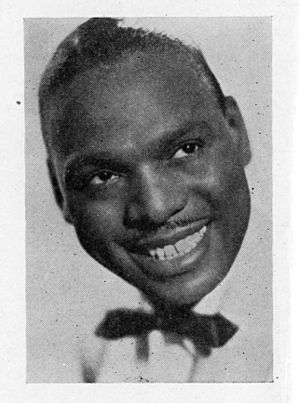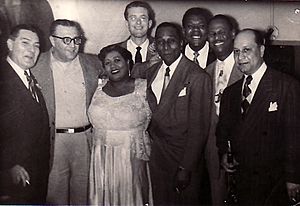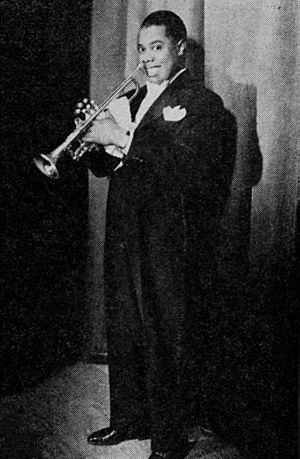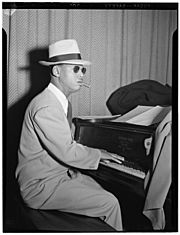Earl Hines facts for kids
Quick facts for kids
Earl Hines
|
|
|---|---|

Hines in 1936
|
|
| Background information | |
| Birth name | Earl Kenneth Hines |
| Born | December 28, 1903 Duquesne, Pennsylvania, U.S. |
| Died | April 22, 1983 (aged 79) Oakland, California |
| Genres | Jazz, swing |
| Occupation(s) | Musician, bandleader |
| Instruments | Piano |
| Years active | 1920s–1983 |
| Labels | Columbia, Brunswick, Fantasy, Capitol, RCA Victor, Impulse!, Verve, Delmark, Black & Blue, Black Lion, Chiaroscuro |
Earl Kenneth Hines, also known as Earl "Fatha" Hines (December 28, 1903 – April 22, 1983), was an American jazz pianist and bandleader. He was one of the most important people in the history of jazz piano. Many people say his playing helped shape jazz music.
Famous pianists like Lennie Tristano and Horace Silver said that Earl Hines had a truly unique style. Erroll Garner even put him in the same group as Art Tatum, another jazz legend. Count Basie called Hines "the greatest piano player in the world."
Contents
Who Was Earl Hines?
His Early Life
Earl Hines was born in Duquesne, Pennsylvania, in 1903. This town is about 12 miles from Pittsburgh. His father, Joseph Hines, played the cornet and led a band called the Eureka Brass Band. Earl's stepmother played the organ at church.
Earl first wanted to play the cornet like his dad. But playing it hurt his ears, so he switched to the piano. He took lessons to learn classical piano. By age eleven, he was playing the organ in his Baptist church. He had a great ear and memory. He could play songs after hearing them in theaters. He said he was playing piano in Pittsburgh before the word "jazz" was even invented.
Starting His Career
When he was 17, Earl Hines left home with his father's permission. He got a job playing piano with Lois Deppe and His Symphonian Serenaders. This was at a nightclub in Pittsburgh called the Liederhaus. He earned $15 a week and got food and a place to stay.
Lois Deppe was a well-known singer. He sang both classical and popular songs. He also took Hines with him on concert trips to New York. In 1921, Hines and Deppe made history. They were the first African Americans to perform on the radio. Hines's first recordings were with Deppe in 1923. One of these was a song Hines wrote called "Congaine."
In 1925, Hines moved to Chicago, Illinois. At that time, Chicago was the jazz capital of the world. He first played at the Elite No. 2 Club. Soon, he joined Carroll Dickerson's band. He even toured with them to Los Angeles.
Meeting Louis Armstrong
Hines met Louis Armstrong in Chicago. Hines was 21, and Armstrong was 24. They played the piano together at the Black Musicians' Union. Armstrong was amazed by Hines's unique "trumpet-style" piano playing. Hines often played very fast octaves. This helped people hear him clearly in the audience.
Armstrong and Hines became close friends. Armstrong joined Hines in Carroll Dickerson's band. They played at the Sunset Cafe. In 1927, this band became Armstrong's band. Hines was the musical director. Later that year, Armstrong hired Hines for his famous Hot Five recording band.
Armstrong and Hines recorded some of the most important jazz songs ever made. One famous song was "West End Blues." They didn't even hear the final version until it was released. Hines said they were amazed by how good it sounded.
The Sunset Cafe closed in 1927. Hines, Armstrong, and drummer Zutty Singleton decided to stick together. But things didn't work out as planned. Hines briefly went to New York. When he came back, Armstrong and Singleton had joined another band.
Hines then joined clarinet player Jimmie Noone at the Apex. This was a club that stayed open late. He played there every night from midnight to 6 a.m. In 1928, he recorded many songs with Noone and Armstrong. He also recorded his first piano solos that year. Most of these were songs he wrote himself.
Hines later married Janie Moses in 1947. They had two daughters, Janear and Tosca.
Leading His Own Band
On December 28, 1928, which was his 25th birthday, Hines started his own big band. They played at Chicago's Grand Terrace Cafe. This was a very important job in the jazz world. For the next 12 years, Hines's band was the main orchestra at the Grand Terrace.
The Hines Orchestra sometimes had up to 28 musicians. They performed three shows every night. On Saturdays and sometimes Sundays, they did four shows. The Grand Terrace was a very popular place. Many people listened to Hines and his band on the radio. Their broadcasts went all across America. The Hines band became the most broadcast band in the country.
Many young musicians listened to Hines. These included Nat King Cole and Jay McShann. Art Tatum was also a very important "student" of Hines.
Many famous musicians played in Hines's band. These included Dizzy Gillespie and Charlie Parker. Sometimes, Hines let other pianists play for him. This allowed him to lead the whole band. Nat King Cole and Teddy Wilson were some of these pianists.
Every summer, Hines toured with his band for three months. They even traveled through the Southern states. This was the first black big band to do so. Hines explained that they had to eat at certain times when traveling by train.
The Birth of Bebop
In 1942, Hines gave Charlie Parker his first big chance. Parker later left the band because he often showed up late. Dizzy Gillespie joined the band the same year.
The Grand Terrace Cafe closed in 1940. Hines, who was 37, took his band on tour full-time for the next eight years. He turned down offers to join Benny Goodman's band.
Hines's band faced challenges during World War II. Many members were drafted into the armed forces. In 1943, six musicians were drafted. Hines had to cancel his tour. He then hired a 12-piece all-woman band. Later, he expanded it to 28 musicians, including men and women. Despite these difficulties, Hines kept touring. He even filled in for Duke Ellington in 1944 when Ellington was sick.
During this time, late-night jam sessions happened with members of Hines's band. These sessions helped create a new style of jazz called bebop. Ellington later said that the ideas for bebop were in Earl Hines's piano style.
Many modern players joined Hines's band. These included Parker, Gillespie, Gene Ammons, and Sarah Vaughan. Vaughan became the band's singer in 1943.
Dizzy Gillespie said that the Hines band was "beautiful." He added that Hines was a master and taught them a lot about self-discipline.
In 1947, Hines bought a nightclub in Chicago called The El Grotto. But big-band music was becoming less popular. The club didn't do well.
Rediscovery

In 1948, Hines joined Louis Armstrong again. He played in Armstrong's "All-Stars" small band. Armstrong became very famous. He was even on the cover of Time magazine. Hines felt like he was just a sideman compared to his old friend. Hines left the All Stars in 1951.
After that, Hines led his own small groups. He toured the United States. In 1954, he toured with the Harlem Globetrotters. By the early 1960s, Hines settled in Oakland, California. He opened a tobacco shop and almost stopped playing music.
In 1964, a friend named Stanley Dance convinced Hines to perform in New York. These were Hines's first piano recitals. They were a huge success! People were amazed by his playing. John Wilson of The New York Times asked, "What is there left to hear after you've heard Earl Hines?"
Hines then won the 1966 International Critics Poll for DownBeat magazine's Hall of Fame. DownBeat also named him the world's "No. 1 Jazz Pianist" many times. He was invited to appear on TV shows.
From then until he passed away, Hines recorded many albums. He played solo and with other famous musicians. He recorded with Dave Brubeck, Duke Ellington, Ella Fitzgerald, Dizzy Gillespie, and Sarah Vaughan.
His solo recordings from this time are highly praised. People said he sounded like "a whole orchestra by himself." In the 1970s, Hines recorded tribute albums to other musicians. He recorded 16 albums in 1974 alone. He became known for recording a whole solo album in just an hour and a half.
From 1964 on, Hines often toured Europe. He also toured South America, Asia, Australia, and Japan. In 1966, he toured the Soviet Union. He performed 35 concerts there. The 10,000-seat Kyiv Sports Palace was completely sold out.
Final Years
Hines continued to play wonderfully in his later years. He sometimes sang as he played. In 1975, a TV documentary was made about him. The International Herald Tribune called it "the greatest jazz film ever made." In the film, Hines said he was "an explorer" always "looking for something."
In 1979, Hines was honored in the Black Filmmakers Hall of Fame. He played solo at Duke Ellington's funeral. He also played solo twice at the White House. He played for the President of France and for the Pope. Hines said, "Usually they give people credit when they're dead. I got my flowers while I was living."
Earl Hines's last show was in San Francisco. He passed away a few days later from a heart attack in Oakland. His piano was sold to help talented music students who needed financial support. It had a special plaque that said:
- presented by jazz lovers from all over the world. this piano is the only one of its kind in the world and expresses the great genius of a man who has never played a melancholy note in his lifetime on a planet that has often succumbed to despair.
Hines was buried in Evergreen Cemetery in Oakland, California.
His Musical Style
The Oxford Companion to Jazz says Hines was "the most important pianist" in the change from stride to swing jazz.
Pianist Teddy Wilson wrote about Hines's style: "Earl's piano style was like a trumpet. He played single notes and octaves in a way that sounded like a horn player. This was very new and exciting."
Oliver Jackson was often Hines's drummer. He also played drums for many other famous jazz musicians.
The Biographical Encyclopedia of Jazz described Hines's style in 1965: "He plays with amazing energy and creativity. He uses big, powerful chords and fast, exciting runs. His music is full of surprises and always sounds fresh."
Discography
- Earl Hines (Columbia, 1951)
- Fats Waller Songs (Brunswick, 1952)
- Louis Armstrong and His Hot Five with Earl Hines (Odeon, 1954)
- Fatha Plays Fats (Fantasy, 1956)
- Solo (America, 1956)
- Oh, "Father"! (Epic, 1956)
- The Incomparable Earl "Fatha" Hines (Tops, 1957)
- The Earl Hines Trio (Epic, 1958)
- Earl Hines (Philips, 1958)
- Earl's Pearls (MGM, 1960)
- A Monday Date (Riverside, 1961)
- Earl "Fatha" Hines (Capitol, 1963)
- Spontaneous Explorations (Contact, 1964)
- Up to Date with Earl Hines (RCA Victor, 1965)
- Paris Session (Columbia, 1965)
- The Real Earl Hines Recorded Live! in Concert (Focus, 1965)
- Once Upon a Time (Impulse!, 1966)
- Stride Right with Johnny Hodges (Verve, 1966)
- Here Comes Earl "Fatha" Hines (Contact, 1966)
- Dinah (RCA Victor, 1966)
- The Great Earl Hines (Polydor, 1966)
- Blues in Thirds (Fontana, 1966)
- Jazz Meanz Hines! (Fontana, 1967)
- Swing's Our Thing with Johnny Hodges (Verve, 1968)
- Blues & Things with Jimmy Rushing (Master Jazz, 1968)
- The Incomparable Earl "Fatha" Hines (Fantasy, 1968)
- "Fatha" Blows Best (Decca, 1968)
- Earl Hines at Home (Delmark, 1969)
- Earl Fatha Hines (Everest, 1970)
- The Quintessential Recording Session (Halycon, 1970)
- Fatha & His Flock on Tour (MPS, 1970)
- Live at the Overseas Press Club with Maxine Sullivan (Chiaroscuro, 1970)
- All Star Jazz Session (Springboard, 1970)
- Tea for Two (Black Lion, 1971)
- Earl Hines Plays Duke Ellington (Master Jazz, 1971)
- Hines Does Hoagy (Audiophile, 1971)
- My Tribute to Louis (Audiophile, 1971)
- Comes in Handy (Audiophile, 1971)
- Hines Plays Hines (Swaggie, 1972)
- Earl Hines (GNP Crescendo, 1972)
- The Mighty Fatha (Flying Dutchman, 1973)
- Tour de Force (Black Lion, 1972)
- Quintessential Continued (Chiaroscuro, 1973)
- Earl Hines Plays George Gershwin (1973)
- Earl Hines at Sundown (Black and Blue, 1974)
- It Don't Mean a Thing If It Ain't Got That Swing! with Paul Gonsalves (Black Lion, 1974)
- Earl Hines Plays Cole Porter (Swaggie, 1974)
- Hines '74 (Black & Blue, 1974)
- Quintessential '74 (Chiaroscuro, 1974)
- Another Monday Date (Prestige, 1974)
- Earl Hines in New Orleans Vol. 1 (Up, 1975)
- Tour de Force Encore (Black Lion, 1975)
- Earl Hines in New Orleans Vol. 2 (1975)
- Duet! (MPS, 1975) – with Jaki Byard
- West Side Story (Black Lion, 1975)
- At the Village Vanguard with Roy Eldridge (Xanadu, 1975)
- Fireworks (RCA, 1975)
- Earl Hines at Club ... Vol. 5 (Storyville, 1976)
- Hot Sonatas with Joe Venuti (Chiaroscuro, 1976)
- Live at Buffalo (Improv, 1976)
- Earl Hines at Saralee's (Fairmont, 1976)
- Earl Hines in New Orleans (Chiaroscuro, 1977)
- Lionel Hampton Presents Earl Hines (Who's Who in Jazz, 1977)
- The Giants with Stephane Grappelli (Black Lion, 1977)
- An Evening with Earl Hines (Chiaroscuro, 1977)
- Live at the New School (Chiaroscuro, 1977)
- Solo Walk in Tokyo (Biography, 1977)
- Swingin' Away (Black Lion, 1977)
- Jazz Is His Old Lady...and My Old Man with Marva Josie (Catalyst, 1977)
- Earl Meets Harry (Black and Blue, 1978)
- One for My Baby (Black Lion, 1978)
- The Dirty Old Men (Black and Blue, 1978)
- Earl Fatha Hines and His All Stars (GNP Crescendo, 1978)
- We Love You Fats with Teresa Brewer (Doctor Jazz, 1978)
- Partners in Jazz with Jaki Byard (MPS, 1978)
- Linger Awhile (Bluebird, 1979)
- The Indispensable Earl Hines Vol. 1 and 2 (RCA, 1979)
- The Indispensable Earl Hines Vol. 3 and 4 (RCA, 1981)
- Deep Forest (Black Lion, 1982)
- The Legendary Little Theater Concert of 1964 Vols. 1 & 2 (Muse, 1983)
- Texas Ruby Red (Black Lion, 1983)
- Fatha (Quicksilver, 1983)
- Live and in Living Jazz (Quicksilver, 1983)
- Earl Hines and His Esquire All Stars Featuring Dicky Wells (Storyville, 1985)
- Varieties! (Xanadu, 1985)
- Earl's Backroom and Cozy's Caravan (Felsted, 1986)
- Live at the Village Vanguard (Columbia, 1988)
- Earl Hines Plays Duke Ellington (1988)
- Reunion in Brussels (Red Baron, 1992)
- Earl Hines and the Duke's Men (Delmark, 1994)
- Live Aalborg Denmark 1965 (Storyville, 1994)
- Grand Reunion (Verve, 1995)
- Earl Hines Plays Duke Ellington Volume Two (1997)
- Classic Earl Hines Sessions 1928-1943 (Mosaic Records, 2012)
Images for kids
See also
 In Spanish: Earl Hines para niños
In Spanish: Earl Hines para niños





